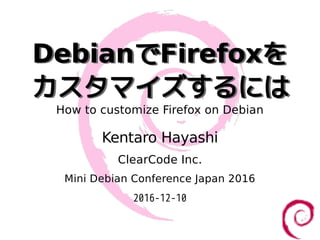顿别产颈补苍で贵颈谤别蹿辞虫をカスタマイズするには
- 1. DebianでFirefoxを カスタマイズするには DebianでFirefoxを カスタマイズするには How to customize Firefox on Debian Kentaro Hayashi ClearCode Inc. Mini Debian Conference Japan 2016 2016-12-10
- 5. パッケージ関連の活動 As a contributor groonga (全文検索エンジン) groonga-normalizer-mysql libhinawa fcitx-imlist hal-?ash (Flashを延命させるアレ) growl-for-linux
- 7. 本日の話題 Today's topics Firefoxのカスタマイズのこと About how to customize Firefox
- 8. 話さないこと I don't talk about... アドオンの作り方 How to create addon WebExtensions
- 9. 会場のみなさんに質問 Question 1 ブラウザは何を使っていますか? What browsers do you love?
- 12. ?refox on debian
- 15. 会場のみなさんに質問 Question 2 Firefoxカスタマイズしていますか? Do you customize Firefox?
- 16. カスタマイズいろいろ Customizing ... 設定メニューからオプションを変更 Tweak via options アドオンをインストール Install addons user.jsを修正する Modify user.js システム全体の設定 System-wide con?guration
- 17. カスタマイズいろいろ Customizing ... 設定メニューからオプションを変更 Tweak via options アドオンをインストール Install addons user.jsを修正する Modify user.js システム全体の設定 System-wide con?guration
- 19. 必須のアドオン Must install these addons Tab Groups ツリー型タブ Tree Style Tab Vimperator 注:個人の感想です。 Personally, I recomends these addons
- 20. アドオン on debian Addons on debian $ apt search xul | grep xul-ext | wc -l 79 aptでインストール可能なパッケージがこれだけあ る
- 21. aptでインストール Easy to install by apt $ sudo apt install xul-ext-iceweasel-branding
- 23. インストールのされかた How xpi is installed? xpiそのままインストール Install xpi as is 展開済みのaddonとしてインストール Install as unpacked addon
- 24. 拡張はどこに? Where is extension installed? $ dpkg -S /usr/lib/firefox/browser/extensions/{972ce4c6-7e08-4474-a285-3208198ce6fd}.xpi firefox: /usr/lib/firefox/browser/extensions/{972ce4c6-7e08-4474-a285-3208198ce6fd}.xpi デフォルトのテーマは xpiとしてインストールされている
- 25. 拡張はどこに? Where is extension installed? /usr/share/xul-ext/iceweasel-brandingに展開 /usr/share/xul-ext/iceweasel-branding ├── chrome │ ├── content │ │ ├── about-logo.png │ │ ├── about-logo@2x.png │ │ ├── about-wordmark.png │ │ ├── about-wordmark.svg │ │ ├── about.png │ │ ├── aboutDialog.css │ │ ├── aboutIceweasel │ │ │ ├── aboutIce.js │ │ │ ├── aboutIce.manifest │ │ │ └── ice.xhtml │ │ ├── browser-overlay.css │ │ ├── icon128.png │ │ ├── icon16.png │ │ ├── icon32.png │ │ ├── icon48.png │ │ ├── icon64.png │ │ └── unofficial │ │ ├── identity-icons-brand.svg │ │ └── silhouette-40.svg │ └── locale │ ├── brand.dtd │ ├── brand.properties │ └── ice.dtd ├── chrome.manifest ├── icon.png ├── icon64.png └── install.rdf
- 26. カスタマイズいろいろ Customizing ... 設定メニューからオプションを変更 Tweak via options アドオンをインストール Install addons user.jsを修正する Modify user.js システム全体の設定 System-wide con?guration
- 27. user.jsを修正する Modify user.js 伝統的なカスタマイズ方法 Traditional way to customize ~/.mozilla/?refox/(プロファイル)/user.jsに置く Put user.js as ~/mozilla/?refox/(pro?le)/user.js
- 28. user.jsの例 Example how to customize user.js user_pref("browser.tabs.closeWindowWithLastTab", false); 最後のタブを閉じたときにウィンドウを閉じない Do not close window even though last tab is closed
- 29. user.jsは万能ではない user.js is suitable for speci?c purpose プロファイルごとに設定 Need to con?gure each pro?le プロファイルで管理されていない項目は不可 It should be managed by pro?le 集中管理するのには不向き Not suitable for centralized management FirefoxSyncでよいのでは? FirefoxSync may be better solution?
- 30. カスタマイズいろいろ Customizing ... 設定メニューからオプションを変更 Tweak via options アドオンをインストール Install addons user.jsを修正する Modify user.js システム全体の設定 System-wide con?guration
- 31. システム全体の設定は How to do system-wide con?guration? /etc/?refox/*.js /etc/?refox/以下に置いた任意の.jsで設定できる Any *.js is ok under /etc/?refox/
- 32. Debian固有の設定 Debian speci?c con?guration 設定ファイルの場所 The con?guration ?le is: /usr/lib/?refox/browser/defaults/syspref/ ?refox.js-> /etc/?refox/?refox.js
- 33. Debian固有の設定(1) Debian speci?c con?guration 拡張の更新を有効 Enable to update extensions pref("extensions.update.enabled", true);
- 34. Debian固有の設定(2) Debian speci?c con?guration LANGに応じてロケールを設定 Use LANG environment variable to choose locale pref("intl.locale.matchOS", true);
- 35. Debian固有の設定(3) Debian speci?c con?guration 既定のブラウザチェック無効 Disable default browser checking pref("browser.shell.checkDefaultBrowser", false);
- 36. Debian固有の設定(4) Debian speci?c con?guration OpenH264は無効 Disable OpenH264 pref("media.gmp-gmpopenh264.enabled", false);
- 37. Debian固有の設定(5) Debian speci?c con?guration 新規タブはクラシックスタイルに Default to classic view for about:newtab sticky_pref("browser.newtabpage.enhanced", false);
- 38. Debian固有の設定(6) Debian speci?c con?guration ヘルスレポートは無効 Disable health report upload pref("datareporting.healthreport.uploadEnabled", false);
- 45. 組織利用の観点だと Point of view from organizations プロキシの設定をしたい 統計情報は送りたくない 勝手にアップデートしない
- 46. 組織内向けカスタマイズ How to customize for organization Mozilla Japan 法人向け情報 https://www.mozilla.jp/business/
- 47. 参考記事の紹介(1) Blog entry how to customize 「Firefox?Thunderbirdの組織内向けカスタマイズの 方法の簡単な紹介と比較」 http://www.clear-code.com/ blog/2014/3/27.html
- 48. 参考記事の紹介(2) Blog entry how to customize user.js MCD ActiveDirectoryのポリシー CCK2 Wizard その他
- 49. MCD? McDonald?
- 50. MCDとは? What is MCD? Mission Control Desktop Netscape由来の集中管理機構 autocon?g.jsとautocon?g.cfg
- 57. ?refox-support- common カスタマイズ事例集のリポジトリ There are use cases in this repository
- 58. ?refox-support- common con?gurations/customization-items.ods 具体的なカスタマイズ方法が記載 Practical use cases are there
- 66. どうやって? How? カスタマイズ用のアドオンを活用 Use speci?c addons to customize
- 67. カスタマイズのアドオン Addon to customize GlobalChrome.css UI Text Overrider Force Addon Status
- 68. カスタマイズのアドオン Addon to customize GlobalChrome.css UI Text Overrider Force Addon Status
- 69. GlobalChrome.css ユーザースタイルシート機能 Provides user stylesheet globalChrome.cssを所定の場所に配置 Put globalChrome.css in speci?c path https://addons.mozilla.org/ja/?refox/addon/ globalchromecss/
- 70. カスタマイズのアドオン Addon to customize GlobalChrome.css UI Text Overrider Force Addon Status
- 71. UI Text Overrider UI要素のラベルやツールチップテキストなどを変 更 Enable to customize UI labels, tooltips and so on https://addons.mozilla.org/ja/?refox/addon/ ui-text-overrider/
- 72. カスタマイズのアドオン Addon to customize GlobalChrome.css UI Text Overrider Force Addon Status
- 76. GlobalChrome.css @-moz-document url-prefix("chrome://browser/content/browser.xul") { (セレクタ), *[always-hidden="true"] { display: none !important; -moz-user-focus: ignore !important; } }
- 77. UI Text Overrider(1) // disable shortcuts and UI var killedItems = []; var killedItemsWithDelay = []; var hiddenItemsWithDelay = [];
- 79. UI Text Overrider(3) function setKillItemRule(aIdentifier, aSelector, aDelayed, aDisableCommand) { lockPref("extensions.uitextoverrider@clear-code.com." + aIdentifier, aSelector); lockPref("extensions.uitextoverrider@clear-code.com." + aIdentifier + ".disabled", "true"); lockPref("extensions.uitextoverrider@clear-code.com." + aIdentifier + ".hidden", "true"); lockPref("extensions.uitextoverrider@clear-code.com." + aIdentifier + ".readonly", "true"); if (aDisableCommand) { lockPref("extensions.uitextoverrider@clear-code.com." + aIdentifier + ".command", ""); lockPref("extensions.uitextoverrider@clear-code.com." + aIdentifier + ".oncommand", ""); } lockPref("extensions.uitextoverrider@clear-code.com." + aIdentifier + ".always-hidden", "true"); lockPref("extensions.uitextoverrider@clear-code.com." + aIdentifier + ".delayed", aDelayed == true); } setKillItemRule("killedItems", killedItems.join(","), false, true); setKillItemRule("killedItemsWithDelay", killedItemsWithDelay.join(","), true, true); setKillItemRule("hiddenItemsWithDelay", hiddenItemsWithDelay.join(","), true, false);
- 80. Force Addon Status lockPref("extensions.force-addon-status@clear-code.com.plugins.0.pattern", "^Java((TM)| )"); lockPref("extensions.force-addon-status@clear-code.com.plugins.0.enabledState", 0);"











































































![GlobalChrome.css
@-moz-document url-prefix("chrome://browser/content/browser.xul") {
(セレクタ),
*[always-hidden="true"] {
display: none !important;
-moz-user-focus: ignore !important;
}
}](https://image.slidesharecdn.com/mini-debian-conference-japan-20164210-170108164201/85/Debian-Firefox-76-320.jpg)
![UI Text Overrider(1)
// disable shortcuts and UI
var killedItems = [];
var killedItemsWithDelay = [];
var hiddenItemsWithDelay = [];](https://image.slidesharecdn.com/mini-debian-conference-japan-20164210-170108164201/85/Debian-Firefox-77-320.jpg)






































![[社内LT][Debian] お前はもう使っている-2013/05/24](https://cdn.slidesharecdn.com/ss_thumbnails/lt-debian20130524-131104022409-phpapp02-thumbnail.jpg?width=560&fit=bounds)









































